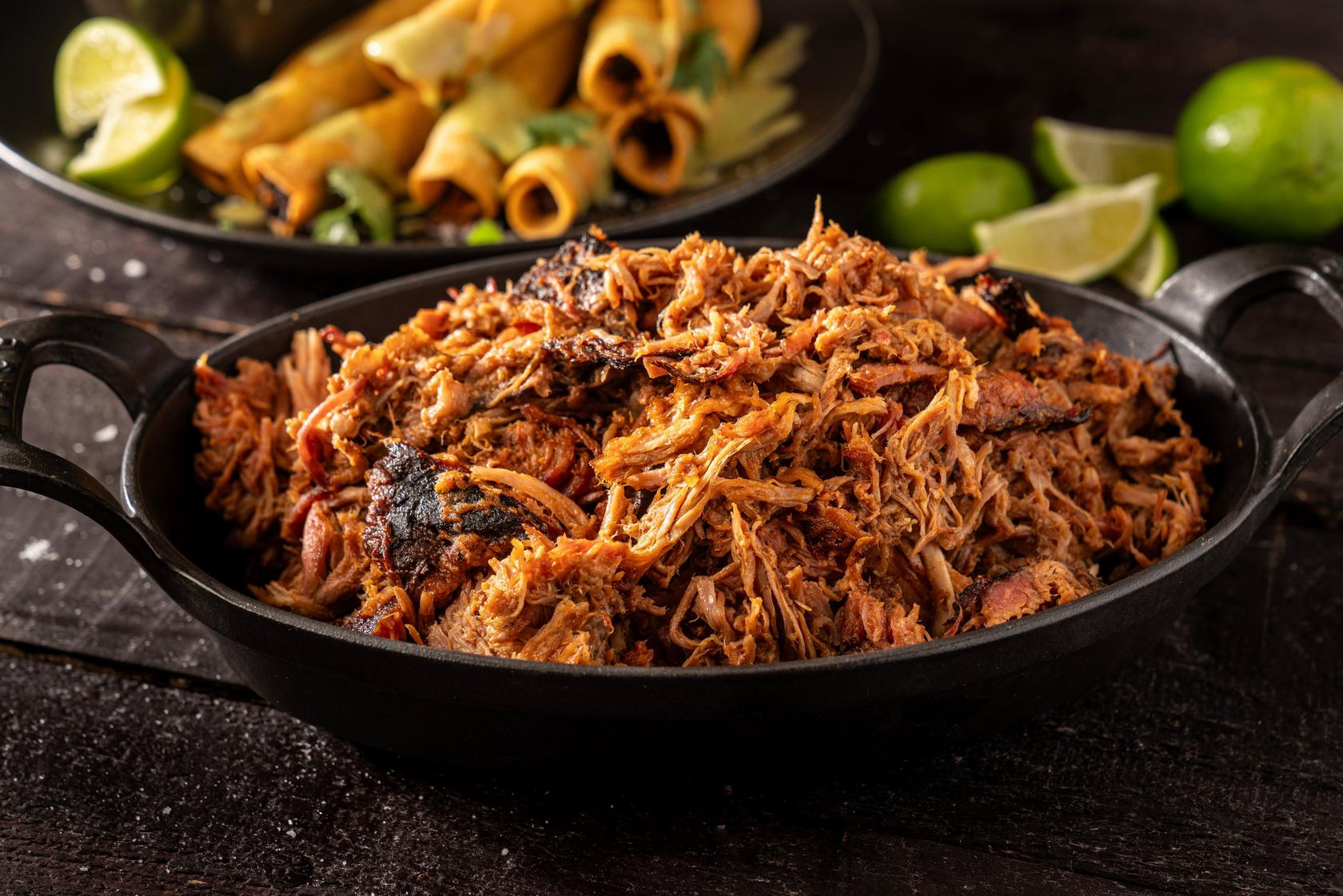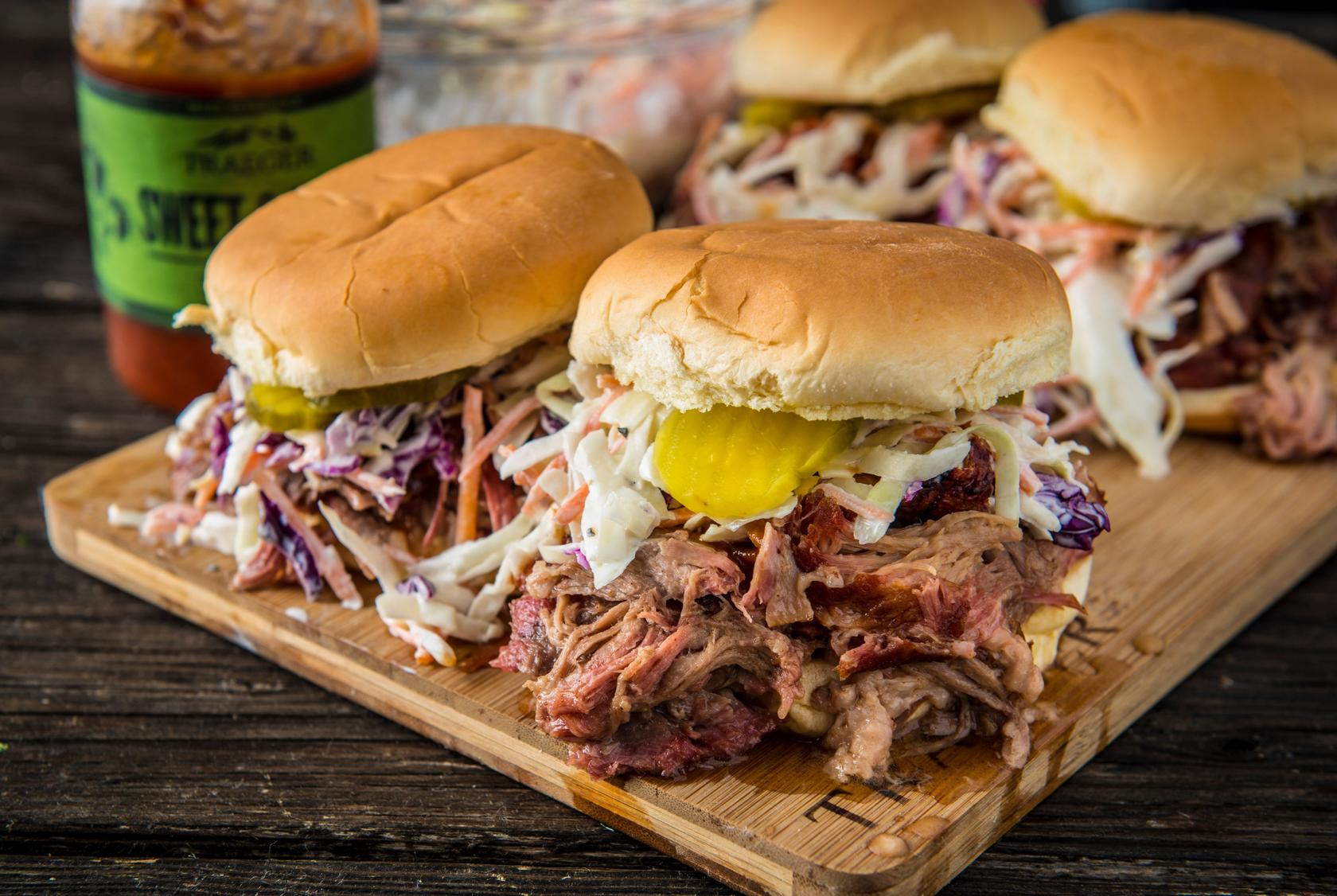
A pork butt may be just about the most confusingly named piece of meat, and that’s saying a lot. This big hunk of meat, perfect for making epic pulled pork, does not come from, well, the butt of the pig. (That is called ham.) A pork butt comes from the front leg, specifically the shoulder. You may think, then, then it’s the same cut as pork shoulder. You would be wrong. In fact, though they are similar in many ways—both are tough cuts that benefit from low and slow cooking—they come from two different places and cook up a little differently. When it comes to pork shoulder vs butt, knowing the difference can help you choose the best cut for your cooking style.
What’s the Difference Between Pork Butt and Pork Shoulder?
Both pork shoulder and pork butt come from the front leg of the pig.
The thicker pork butt sits up higher on the leg and so can contain some of the shoulder blade and neck along with the leg. At the market you might also see this cut labeled as a Boston butt. (One origin story of the confusing term harkens back to ye olde times when New England butchers shipped this cut in barrels called butts. ) Sold bone-in or boneless, the butt comes in a fairly uniform rectangle shape and is well marbled. It often comes with a thick fat cap on it but no skin.
Pork shoulder, comes from lower down on the leg and might also be called a picnic shoulder or picnic roast. (And then there is the confusingly named picnic ham, which is not a ham cut at all, but a part of the front leg that’s been cured and smoked. Ugh.) A pork shoulder is more triangular in shape. If sold boneless, it may be in netting. Pork shoulder usually comes skin-on, which has benefits to be discussed later.
When to Use Pork Butt
With more marbling than pork shoulder, pork butt is our pick for smoking and braising. It’s the best choice for pulled pork. When cooked to the proper temperature (between 200°F and 205°F), the meat becomes meltingly tender and shreds easily. Because of the ample fat, it does not dry out easily, especially when bone-in because the bone helps it keep its shape to cook more evenly.
Pork Butt Recipes
Most of the recipes calling for pork butt have you smoking is slowly than shredding it. One great thing about both cuts is the mild flavor of the meat takes well to all kinds of seasoning and sauces.
For a classic take on pulled pork with great tips on prepping and smoking, try Meat Church Pulled Pork by pitmaster Matt Pittman.
If you’re in the mood for taco-perfect pork that pack a little heat, try this Chipotle Smoked Pork Butt.
For even more adventure, try Traeger Style Bossam. Inspired by David Chang’s famous Momofuku dish, it’s pulled pork with a Korean accent.
And don’t forget about pulled pork leftovers. Because it’s generally a large piece of meat, chances are you’ll have leftover shredded pork. Good news! Not only does it freeze well, but you can find tons of delicious ways to use it from pulled pork eggs Benedict to mac and cheese.

When to Use Pork Shoulder
One of the best things pork shoulder has going for it is that it usually comes skin on. That skin, cooked right, can turn out deliciously crackling. For that reason, roasting is a good choice for cooking this cut. That said, you don’t want to cook it at too high of a heat. And while you can shred it if cooked long enough, most recipes for pork shoulder call for it to be sliced. That means pulling it off the heat at a lower internal temperature so the meat will hold its shape.
Pork Shoulder Recipes
Pork shoulder tends to be roasted, but it also works well smoked and braised.
Chef Tim Hollingsworth coats pork shoulder in a rich glaze and pairs it with a romesco sauce in his Molasses-Glazed Pork Shoulder.
Pernil is a classic and festive Puerto Rican dish featuring pork shoulder that’s doused with spices and citrus.
Because the chunks of pork shoulder hold their shape in this Smoked Pork Chile Verde, it gives the dish a pleasant chew.

How To Make Pulled Pork
Though both pork cuts have their merits, pork butt wins when it comes to making pulled pork, a favorite Traeger dish. Read our article on how to smoke pork butt for pulled pork, but know that if shoulder is ever your only choice, it can work, too; it’ll be a bit different, but it’ll still be tasty.

Smoked Pulled Pork
by Traeger Kitchen
454 Reviews
Prep Time
10 Min
Cook Time
9 Hr
Serves
8
Pellets
Apple
Smoke it low, smoke it slow. This smoked pulled pork recipe is worth the wait, and this versatile smoked pulled pork can be served any way you like. Pro Tip: Smother the freshly shredded pork with one of our signature BBQ sauces for the ultimate taste.
Ingredients
main
| 1 | (6-9 lb) bone-in pork butt |
| Traeger Pork & Poultry Rub | |
| 2 Cup | apple cider |
| To Taste | Traeger 'Que BBQ Sauce |
1
Start this pulled pork recipe by trimming the pork butt of excess fat. Generously season it all over with Traeger Pork & Poultry Rub. Let sit while you heat the grill.
2
Meanwhile, preheat the Traeger with the lid closed to 250°F; this will take about 15 minutes.
3
Insert a leave-in meat thermometer into the pork butt aiming for the center and avoiding any bone. Place the pork butt fat side up directly on the grill grate and cook until the internal temperature reaches 160°F, 3 to 5 hours. The time will vary depending on the size of the pork butt, the weather, and your grill.
4
On a large baking sheet, stack 4 large pieces of aluminum foil on top of each other, ensuring they are wide enough to wrap the pork butt entirely on all sides. If not, overlap the foil pieces to create a wider base. Transfer the pork butt to the center of the foil fat side up, then bring up the sides of the foil a little bit to create a boat before pouring the apple cider on top of the pork butt. Wrap the foil tightly around the pork, ensuring the tip of the meat thermometer is exposed and the cider does not escape for delicious Traeger pulled pork.
5
Place the foil-wrapped pork butt back on the grill fat side up and cook until the internal temperature reaches 204°F, another 3 to 4 hours.
6
Remove the pork from the grill. Allow the pork to rest for 45 minutes in the foil.
7
Remove the pork from the foil and pour off any excess liquid into a fat separator.
8
Shred the meat, removing and discarding the bone and any excess fat. Add the separated liquid back into pork and season to taste with additional Pork & Poultry Rub. Optionally, add Traeger 'Que BBQ Sauce or your favorite BBQ sauce to taste.
9
Serve alone, in your favorite recipes, or on sandwiches. Refrigerate leftover pork in a covered container for up to 4 days. You can also freeze it for longer storage. Enjoy!